先回顾论文的思想,再进一步讨论改进,本方法我进行了复现,但是没有将卷积乘法改成int型乘法,因为服务器没法做:
1、本方法属于线性量化,如下式,q是fp32的r的量化后的值:
![]()
将最小值也做了对应的量化(zero-point)。
- 讨论矩阵乘法的整形运算(我觉得是本文最精华的地方)
流程如下式所示,式2->式3->式4->式5:
![]()
![]()


由上可知,除了M以外,全部是整数,同时,我们进一步的将乘以M这个浮点操作转化为整数运算和移位运算的合成:
![]()
将M0控制在[0.5,1]范围内,应该是更好的表达成int32类型。
接下来,缩减公式4的运算参数,将公式4转化为公式7:
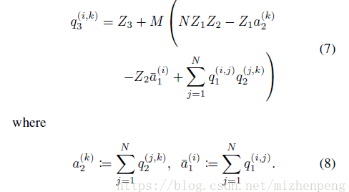

公式8可以用2n^2(2*n的平方-为什么是这个呢:因为M的计算是2的n次方,里面a1,a2的计算也是2的n次方,相乘就是2的2*n次方),剩下的运算集中在公式9中(计算复杂度-2n^3(2*n的3次方-同理)):
但是此处uint8的乘法需要使用int32来存储,即如下:

第三步,将bias表示为int32,对应的量化参数为:
![]()
并将r_bias=s_1*s_2*q_bias加到公式3右边,再转化到公式7的形式转化后,公式7括号里面运算就变成了int32的类型,在乘以M可以看成现诚意int32类型的定点数M0,然后再进行移位,最后将结果在(0,255]进行截取,来实现uint8的输出,此事不再需要使用relu。
3、模拟量化训练
需要量化的地方插入伪量化节点,如果有bn层,则需要将bn层的参数再量化前foled-into权重中;激活值的量化在激活函数以后或者resnet的shortcut以后进行。
伪量化流程如下:
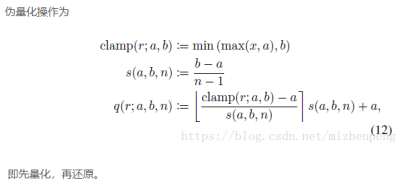
量化流程分别针对权重个激活值:
- 对于权重,a,b直接按照通道使用最大最小值
- 对于激活值,a,b使用EMA来计算得到(注意BN的w-fold流程是不一样的)
以上两点将根据我复现的代码进行进一步的解析,接下来我们看详细的伪量化流程:
1、不带bn层的伪量化
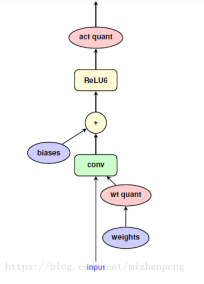
注意,这个图是量化图,但实际理解应该是伪量化图,因为最关键的量化卷积计算int_conv并没有体现。
2、bn层的folding
由bn层时需要将bn层考虑进入权重,在进行量化:

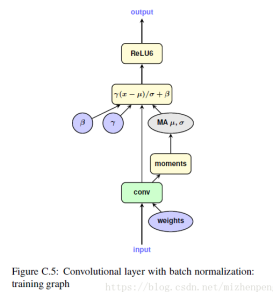
训练时候的正常bn层示意图
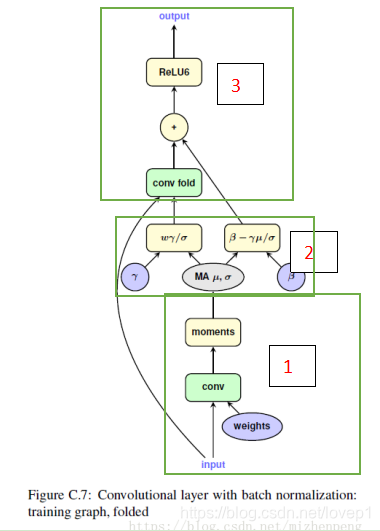
训练时fold_bn的示意图
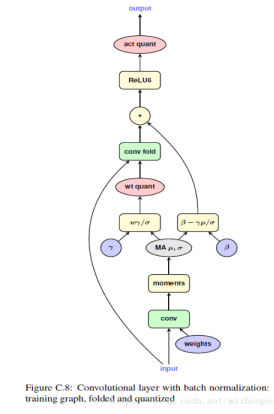
训练时fold_bn并且伪量化示意图
由上图可知,
- 正常训练时计算结果后直接输入bn层然后进行relu6。
- 训练时fold_bn层也很好理解,先使用1部分进行正常的卷积计算,再使用2部分将卷积计算的结果与bn层融合到进行拆分,将其当做新的卷积权重和偏置,最后使用3部分进行fold的卷积计算。
- 原理同2,但是在第2部分时先对fold的卷积权重进行了量化,第3部分最后对激活值进行了量化。
更进一步的讨论,如果每一层都需要量化、反量化,会带来大量的不必要计算和复杂度,如果下一层也是conv-bn-relu,可以不用反量化,如下图所示,下图将激活函数量化在了pipline里面,所以不用频繁量化反量化:
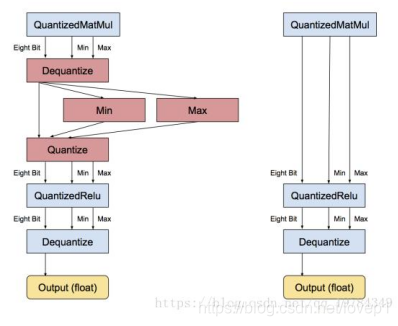
存疑:
1、直接进行前向推理时,当前推理bn层的时bn参数没有固定,那如何进行bn的融合?
解:方案1-在前向训练的时候跑两遍,第一遍前向求出activation的均值和方差,在后第二遍再将均值和方差融入进w,成为w_fold
2、代码复现时细节和问题
解:1、注意,bn层计算的是本层的均值和方差,所以在推理一定要先计算本层的输出,再计算bn的均值和方差。
2、注意:基于google的INQ方法不需要选择阈值来做饱和量化模式,对权重,选择实际使用的通道/层的最大最小值决定量化参数,对于激活输出,使用batches的最大最小值的滑动平均值来决定量化参数,因为我们使用了先训练后量化的方法,本身精度就是得到保证的。
3、如果只量化权重不量化激活呢:
解:白皮书指出,这对减小模型内存大小是很有作用的,但不考虑浮点的计算输出性能开销。
- 从白皮书的结论给出:
激活值的8bit量化精度损失很小,由于以下原因,激活值的动态范围很小:1、无缩放的批归一化 2、relu6将范围固定在0,6之间。
逐层量化权重时,精度损失会非常严重,但是指出,激活值仍然需要逐层对称量化来量化。
参考链接:Quantization and Training of Neural Networks for Efficient Integer-Arithmetic-Only Inference-CSDN博客







 本文探讨了一种线性量化方法,通过整数运算替代浮点运算以优化神经网络的效率。核心在于将矩阵乘法转化为整数运算和移位操作,减少了计算复杂度。量化训练过程中,权重和激活值的量化策略不同,权重采用最大最小值,而激活值使用EMA计算。在不包含BN层和包含BN层的情况下,分别展示了量化流程,并指出在特定情况下可以避免不必要的量化反量化操作以提高效率。此外,文章讨论了仅量化权重不量化激活的策略,以及在前向推理时BN层融合的处理方式。
本文探讨了一种线性量化方法,通过整数运算替代浮点运算以优化神经网络的效率。核心在于将矩阵乘法转化为整数运算和移位操作,减少了计算复杂度。量化训练过程中,权重和激活值的量化策略不同,权重采用最大最小值,而激活值使用EMA计算。在不包含BN层和包含BN层的情况下,分别展示了量化流程,并指出在特定情况下可以避免不必要的量化反量化操作以提高效率。此外,文章讨论了仅量化权重不量化激活的策略,以及在前向推理时BN层融合的处理方式。

















 4112
4112

 被折叠的 条评论
为什么被折叠?
被折叠的 条评论
为什么被折叠?








